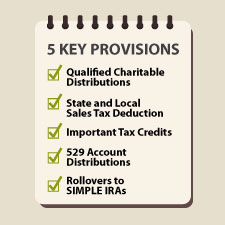PATH Act of 2015: 5 Key Tax Provisions Your Clients Need to Know
by Commonwealth Financial Network
 On Friday, December 18, 2015, President Obama signed the Consolidated Appropriations Act of 2016—which contains the Protecting Americans from Tax Hikes (PATH) Act of 2015—into law. As a result, several key tax provisions that had expired or were set to expire within the next two years are now permanent. Not only that, but many of these provisions were made retroactive for all of 2015.
On Friday, December 18, 2015, President Obama signed the Consolidated Appropriations Act of 2016—which contains the Protecting Americans from Tax Hikes (PATH) Act of 2015—into law. As a result, several key tax provisions that had expired or were set to expire within the next two years are now permanent. Not only that, but many of these provisions were made retroactive for all of 2015.
How could this act affect your clients’ tax planning strategies? Let’s take a closer look at the PATH Act of 2015, including five of its key tax provisions, to help you understand this wide-ranging legislation and the potential financial ramifications for your clients.
For those clients who are at least age 70½, the QCD provision permits tax-free distributions directly from an IRA or a Roth IRA to a qualified charity. The donation is limited to $100,000 per person, although married taxpayers filing jointly may exclude up to $100,000 donated from each spouse’s own IRA. QCDs can also partially or fully satisfy your client’s required minimum distribution for the current tax year. It’s important to note that these provisions will apply retroactively to QCDs made from January 1, 2015, going forward.
Here are a few additional considerations that your clients should keep in mind:
- The withdrawal is a tax-free distribution; as a result, the amount excluded from gross income is not tax-deductible.
- The benefit is available to those clients who do not itemize deductions and, therefore, would not otherwise be able to take a deduction. For those who do itemize, the rollover will be excluded from the calculation of their adjusted gross income (AGI).
- Donations from an inherited IRA are eligible if the beneficiary is at least age 70½.
- Donations from a SEP IRA or SIMPLE IRA are not eligible.
- The charitable recipient must be a 501(c)(3) charity. Nonoperating private foundations, supporting organizations, and donor-advised funds do not qualify.
To help your clients find organizations that are eligible to receive tax-deductible charitable contributions, encourage them to use the IRS’s Exempt Organizations Select Check tool.
Another important provision of the PATH Act concerns state and local sales tax deductions. Under PATH, those clients who itemize their deductions are now permanently permitted to deduct sales tax payments—instead of state and local income taxes—on their federal tax returns, if they so choose. This option is particularly important for those living in states without an income tax, including Florida, Texas, and Washington.
You and your clients are likely familiar with the following tax credits. But what’s important to note is that these credits are now permanent under this new legislation.
Enhanced child tax credit. Clients with children can now claim a tax credit of up to $1,000 per qualifying child. If the value of the credit exceeds the amount of taxes owed, a portion of the credit is refundable. PATH has permanently set the refundable portion of this credit at 15 percent of earned income in excess of $3,000.
Earned Income Tax Credit (EITC). Since 2009, the EITC amount has been increased for families with three or more children, while the marriage penalty has been reduced by increasing the AGI phaseout range by $5,000 for couples who are married and filing jointly. Although these changes were scheduled to expire in 2017, the PATH Act has made them permanent.
American Opportunity Tax Credit. This credit was slated to expire in 2017, but it, too, is now permanent. This provision allows a credit of up to $2,500 to offset the cost of postsecondary education for some taxpayers.
There is an alternative of which your clients should be aware. They may elect to take an above-the-line deduction of up to $4,000 of tuition and fees for eligible students. This deduction is reduced to $2,000 for married couples with AGI in excess of $130,000 ($65,000 for individuals) and is eliminated entirely once AGI exceeds $160,000 ($80,000 for individuals). This above-the-line deduction option was extended through the end of 2016.
PATH has expanded the definition of qualified higher education expenses (QHEEs) to include computer equipment and technology, as well as related software, Internet access, and services for beneficiaries during their years of enrollment. In addition, refunds of tuition paid with 529 distributions are considered QHEEs and can be rolled back into a 529 account within 60 days of the refund. This provision is effective for distributions or refunds made in 2015. For refunds made in 2014, the provision will be effective for those recontributed to a 529 within 60 days of enactment.
Another important change to note concerns 529 account balances. Prior to the enactment of the PATH Act, 529 account balances were aggregated together to determine the amount of any nonqualified distribution that would be considered principal versus gain. (Nonqualified distributions are those that are not made for QHEEs.) As a result of PATH, however, nonqualified distributions are taxed based on the gains and principal in the distributing account.
Finally, your clients will now be permitted to roll assets from traditional and SEP IRAs, as well as from employer-sponsored retirement plans such as a 401(k), into a SIMPLE IRA, provided that the plan has existed for at least two years. Rollovers from Roth IRAs will not be permitted. This provision will be effective for rollover contributions made after PATH enactment.
As you can see, the PATH Act could have consequences for many of your clients, from education expenses to retirement accounts. But by educating yourself on its various provisions, you will be able to guide their tax planning strategies and answer any questions they may have regarding this legislation.
Which aspect of this legislation will have the biggest impact on your clients? Will the act affect your tax planning strategies? Please share your thoughts with us below.
This material has been provided for general informational purposes only and does not constitute either tax or legal advice. Although we go to great lengths to make sure our information is accurate and useful, we recommend you consult a tax preparer, professional tax advisor, or lawyer.
Commonwealth Financial Network is the nation’s largest privately held independent broker/dealer-RIA. This post originally appeared on Commonwealth Independent Advisor, the firm’s corporate blog.
Copyright © Commonwealth Financial Network

















